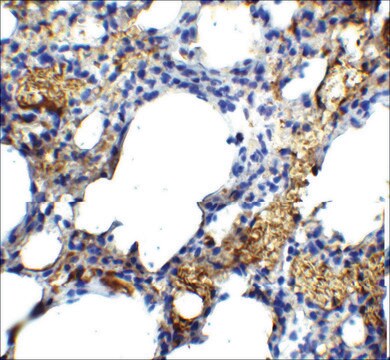MABC1723
Anti-TM4SF1 Antibody
About This Item
Produits recommandés
Source biologique
mouse
Niveau de qualité
Conjugué
unconjugated
Forme d'anticorps
purified antibody
Type de produit anticorps
primary antibodies
Clone
8G4, monoclonal
Poids mol.
calculated mol wt 21.63 kDa
Conditionnement
antibody small pack of 100 μL
Isotype
IgG1κ
Numéro d'accès UniProt
Conditions d'expédition
dry ice
Température de stockage
-10 to -25°C
Modification post-traductionnelle de la cible
unmodified
Informations sur le gène
human ... TM4SF1(4071)
Description générale
Spécificité
Immunogène
Application
Evaluated by Immunocytochemistry in human umbilical vein endothelial cells (HUVEC).
Immunocytochemistry Analysis: A 1:250 dilution of this antibody detected TM4SF1 in human umbilical vein endothelial cells (HUVEC).
Tested Applications
Flow Cytometry Analysis: A representative lot detected TM4SF1 in Flow Cytometry applications (Lin, C.I., et. al. (2014). Angiogenesis. 17(4):897-907).
Western Blotting Analysis: A representative lot detected TM4SF1 in Western Blotting applications (Sciuto, T.E., et. al. (2015). Biochem Biophy Res Commun. 465(3):338-443).
Immunoprecipitation Analysis: A representative lot immunoprecipitated TM4SF1 in Immunoprecipitation applications (Sciuto, T.E., et. al. (2015). Biochem Biophy Res Commun. 465(3):338-443).
Immunocytochemistry Analysis: A representative lot detected TM4SF1 in Immunocytochemistry applications (Lin, C.I., et. al. (2014). Angiogenesis. 17(4):897-907).
Electron Microscopy: A representative lot detected TM4SF1 in Electron Microscopy applications (Sciuto, T.E., et. al. (2015). Biochem Biophy Res Commun. 465(3):338-443).
Inhibition Analysis: A representative lot blocked the formation new blood vessels in Matrigel plugs. (Lin, C.I., et. al. (2014). Angiogenesis. 17(4):897-907).
Note: Actual optimal working dilutions must be determined by end user as specimens, and experimental conditions may vary with the end user
Forme physique
Stockage et stabilité
Autres remarques
Clause de non-responsabilité
Vous ne trouvez pas le bon produit ?
Essayez notre Outil de sélection de produits.
Code de la classe de stockage
12 - Non Combustible Liquids
Classe de danger pour l'eau (WGK)
WGK 2
Point d'éclair (°F)
Not applicable
Point d'éclair (°C)
Not applicable
Certificats d'analyse (COA)
Recherchez un Certificats d'analyse (COA) en saisissant le numéro de lot du produit. Les numéros de lot figurent sur l'étiquette du produit après les mots "Lot" ou "Batch".
Déjà en possession de ce produit ?
Retrouvez la documentation relative aux produits que vous avez récemment achetés dans la Bibliothèque de documents.
Notre équipe de scientifiques dispose d'une expérience dans tous les secteurs de la recherche, notamment en sciences de la vie, science des matériaux, synthèse chimique, chromatographie, analyse et dans de nombreux autres domaines..
Contacter notre Service technique







